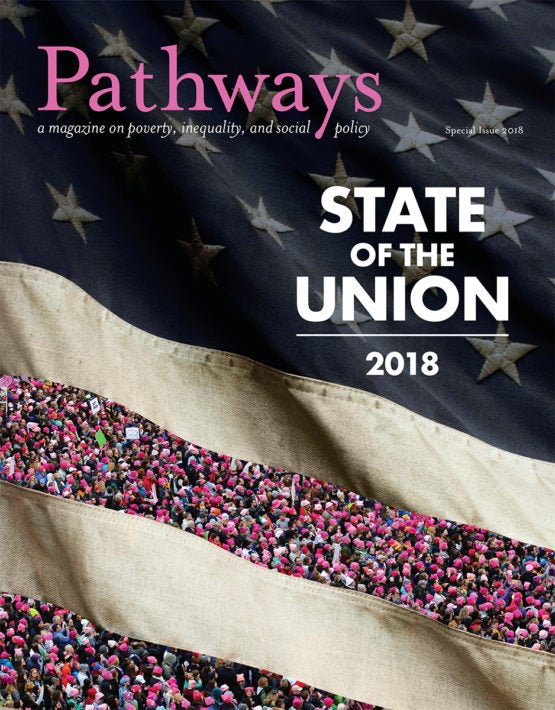Gender equality stalls in the U.S., Stanford report finds
While the country made progress on eliminating gender inequality in the latter half of the 20th century, progress has since slowed or stalled entirely, according to a report released by the Stanford Center on Poverty and Inequality.

A new report from the Stanford Center on Poverty and Inequality says that, for many measures of gender inequality, women rapidly made up ground in the latter half of the 20th century. But progress has since slowed or stalled entirely.
For many measures of gender inequality, women rapidly made up ground in the latter half of the 20th century, but progress has since slowed or stalled entirely, according to a report released March 16 by the Stanford Center on Poverty and Inequality.
The State of the Union report addresses key questions about gender inequality in the United States, such as whether occupational segregation is declining, why there is still so much sexual harassment and discrimination, and when gender gaps in earnings, employment and related labor market outcomes might finally close.
By examining different types of gender inequality at once, it becomes possible to fashion a systematic and coordinated policy response, said David Grusky, director of the Stanford Center on Poverty and Inequality. “Otherwise, it’s all too easy to default to piecemeal policies, each oriented to a single narrow-gauge problem.”
This comprehensive approach reveals that for many outcomes women are not making up ground nearly as rapidly as they did in the 1970s and 1980s. Following World War II, women entered the workforce in record numbers, but the increase in labor force participation for women has now stagnated, and women remain less likely than men to participate in the formal labor force. Similarly, the wage gap declined rapidly in the 1970s and 1980s, but the rate of decline has since slowed.
The report also identifies some disparities that favor women rather than men. For example, on average women live five years longer than men, though life expectancy rates have converged in recent years. “Gender inequality is not a unidimensional problem in which all gaps favor men or all gaps are changing in the same way,” said Marybeth Mattingly, a research consultant at the Stanford Center on Poverty and Inequality and an author of two of the chapters in the report.
Although the pattern of trends is complicated, the stalling-out of previously strong trends shows up repeatedly in the report. This stalling-out is especially prominent when measuring whether women and men are segregated into different types of roles in the family, workplace, and community.
For example, women streamed into formerly male-dominated occupations in the 1970s and 1980s, but the rate of occupational integration slowed after 1990. Even today, relatively few women are a bus driver, carpenter or computer scientist. If rates of integration since 2000 are extrapolated, it would take a full 330 years before the workplace becomes completely integrated. We’re in a new world of “snail’s pace change,” said Kim Weeden, one of the authors of the chapter on occupational segregation.
Why has it proven so difficult for women to enter into historically male-dominated professions? “Stereotypes and unconscious biases are getting in the way of faster social change,” according to Shelley Correll, head of the Clayman Institute for Gender Research and an author of one of the chapters in the report. “We still cling to the view that men and women are fundamentally different in interests and skills,” Correll said. This contributes to segregation both because “employers discriminate on the basis of these beliefs and workers sort themselves into gender-conforming roles,” Correll said.
In the report’s concluding chapter, Correll and Stanford sociologist Marianne Cooper examine the most promising science-based policies for reducing gender inequality. Although “Congress remains gridlocked on gender and family issues,” they note that there have been “many promising developments at the state and local levels and in private industry, including the passage of paid leave policies and interventions within organizations to block unconscious biases from undervaluing women’s accomplishments.”
It’s also important to bear in mind, Grusky points out, that policy is not the only road to change. Even in a world in which standard gender policy has been sidelined, there’s still an important role for “bottom-up change” led by parents, millennials and many others. “It’s becoming more common to encourage girls to take math classes or attend coding camps, to call out gender discrimination when it happens, to divide domestic chores somewhat more evenly and to otherwise challenge conventional gender roles,” Grusky said.
These bottom-up efforts by early adopters may ultimately trigger a quick cascade of change, Grusky said. “A bottom-up revolution – a #MeToo movement writ large – has the potential to bring about a dramatic reduction in gender inequality.”
Stanford scholars contributing to the report are David Grusky, professor of sociology and director of the Stanford Center on Poverty and Inequality, Shelley J. Correll, professor of sociology and director of the Clayman Institute for Gender Research, Mark Duggan, professor of economics and director of the Stanford Institute for Economic Policy Research, Sean F. Reardon, professor of poverty and inequality in education (and sociology, by courtesy), Aliya Saperstein, associate professor of sociology, David S. Pedulla, assistant professor of sociology, Adina D. Sterling, assistant professor of organizational behavior at the Graduate School of Business, Charles Varner, associate director of the Stanford Center on Poverty and Inequality, Marianne Cooper, sociologist at the Clayman Institute for Gender Research, Marybeth Mattingly, Research Consultant at the Stanford Center on Poverty and Inequality, Erin M. Fahle, doctoral student in education policy, Juan Pedroza, Graduate Research Fellow at the Stanford Center on Poverty and Inequality, and Valerie Scimeca, research assistant at the Stanford Institute for Economic Policy Research.
